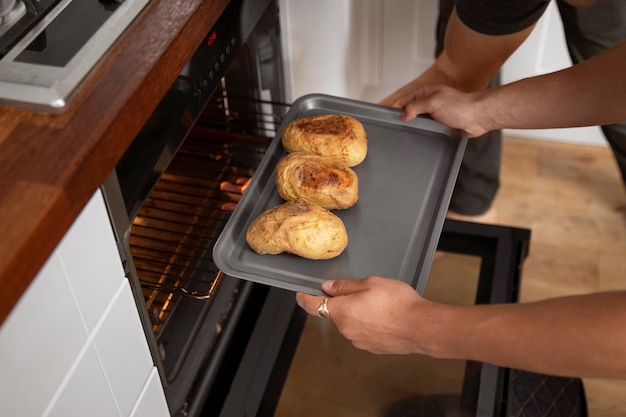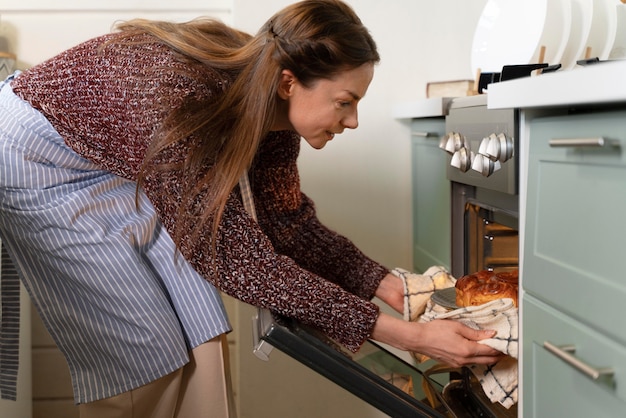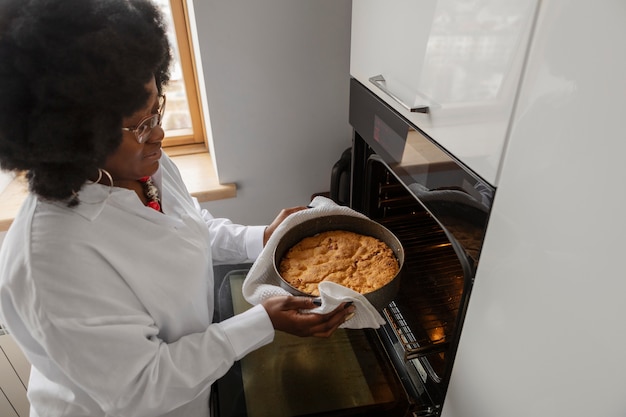There's a certain magic that happens when a roast emerges from the oven, its surface glistening with a golden-brown crust, its aroma filling the air with promises of deliciousness. But achieving that perfect roast, one that's both succulent and flavourful, requires more than just throwing a piece of meat into the oven and hoping for the best. It's about understanding the science behind roasting, mastering the art of temperature control, and incorporating a few essential techniques that elevate the ordinary to the extraordinary. This guide will delve into the nuances of oven temperatures, helping you create roasts that will make you the envy of your dinner guests.
(Part 1) The Science of Roasting: Unveiling the Secrets

The Temperature Tango: A Culinary Symphony
Imagine your oven as the conductor of an orchestra, and the temperature as the baton, guiding the heat to create a harmonious symphony of flavour. A high temperature, like a rapid tempo, brings about a beautifully browned crust, but it can also result in dry, overcooked meat. Conversely, a lower temperature, like a more measured tempo, allows for a more gradual cooking process, resulting in a tender and juicy final product. It's a delicate balance, like a tightrope walk, and the key lies in understanding how different temperatures impact the texture and flavour of your roast.
The Maillard Reaction: The Alchemist of Flavour
Behind that irresistible golden crust lies a fascinating chemical reaction known as the Maillard reaction. This captivating process occurs when sugars and amino acids in the meat interact at high temperatures, creating a complex tapestry of hundreds of new flavour compounds. This magical transformation is the reason behind the captivating aromas that waft from the oven and the delicious crispy exterior that makes us crave more. It's a testament to the power of heat and chemistry, working in tandem to create culinary masterpieces.
The Importance of Resting: A Final Act of Patience
The journey to a perfect roast doesn't end when the meat is removed from the oven. In fact, the resting stage is crucial for achieving optimal results. As the meat rests, the juices, which were forced to the surface during cooking, are redistributed throughout the meat, creating a more tender and juicy final product. It's like letting the flavours settle, allowing the symphony of taste to reach its crescendo. This step, often overlooked, is essential for unlocking the full potential of your roast. Think of it as a final act of patience, allowing the flavours to harmonise before you take the first bite.
(Part 2) Oven Temperature Guide: A Blueprint for Success

Setting the Stage: Choosing the Right Temperature for Your Roast
There's no one-size-fits-all approach when it comes to oven temperatures. The ideal temperature will depend on the cut of meat, its size, and your desired level of doneness. Here's a general guide to help you navigate the temperature landscape, but remember, these are just starting points, and using a meat thermometer to ensure accuracy is always recommended.
Beef: A Symphony of Flavour and Texture
| Cut | Temperature (°C) | cooking time |
|---|---|---|
| roast beef | 180-200 | 20-30 minutes per 500g |
| rib roast | 160-180 | 25-35 minutes per 500g |
| sirloin roast | 180-200 | 20-30 minutes per 500g |
Lamb: A Tender and Aromatic Treat
| Cut | Temperature (°C) | Cooking Time |
|---|---|---|
| Leg of Lamb | 180-200 | 20-30 minutes per 500g |
| Shoulder of Lamb | 160-180 | 30-40 minutes per 500g |
| rack of lamb | 180-200 | 15-20 minutes per 500g |
Pork: A Versatile and Delicious Choice
| Cut | Temperature (°C) | Cooking Time |
|---|---|---|
| pork loin roast | 180-200 | 20-30 minutes per 500g |
| pork shoulder roast | 160-180 | 30-40 minutes per 500g |
| pork belly Roast | 160-180 | 40-50 minutes per 500g |
Chicken: A Classic Culinary Staple
| Cut | Temperature (°C) | Cooking Time |
|---|---|---|
| whole chicken | 180-200 | 60-90 minutes |
| chicken breast | 180-200 | 20-30 minutes |
| chicken thighs | 180-200 | 30-40 minutes |
Turkey: A Festive Feast
| Cut | Temperature (°C) | Cooking Time |
|---|---|---|
| Whole Turkey | 180-200 | 15-20 minutes per kg |
| turkey breast | 180-200 | 15-20 minutes per 500g |
| turkey legs | 180-200 | 30-40 minutes per 500g |
For beef, lamb, and pork, aiming for an internal temperature of 55-60°C for medium-rare, 60-65°C for medium, and 70-75°C for well-done is generally recommended. For chicken, an internal temperature of 85°C ensures it's cooked through and safe to eat.
(Part 3) roasting techniques: Mastering the Art of Heat Management

The Importance of Preheating: Setting the Stage for Success
Before you even consider placing your roast in the oven, ensure it's preheated to the desired temperature. Think of it as warming up your culinary stage before the performance begins. This step is crucial for achieving even cooking and a beautiful golden crust. Give your oven ample time to reach the desired temperature, at least 15 minutes is recommended. Using a fan-assisted oven can help to create a more consistent heat distribution, leading to a more evenly cooked roast.
Seasoning and Searing: Enhancing Flavour and Texture
Seasoning is an essential step that often gets overlooked. Salt and pepper are the classics, but don't be afraid to experiment with herbs, spices, and even a touch of garlic. To enhance flavour and create a beautiful, crispy crust, consider searing the meat before placing it in the oven. This process locks in the juices and adds a delicious depth of flavour. Use a hot pan and sear the roast for about 5 minutes per side, ensuring it's nicely browned before transferring it to the oven.
Basting and Roasting: A Symphony of Moisture and Flavour
Basting, the art of pouring the pan juices over the meat during cooking, plays a vital role in keeping the roast moist and adding a layer of delicious flavour. It's a simple yet effective technique that elevates the roasting experience. Use a spoon to gently pour the pan juices over the top of the roast every 30 minutes. To ensure even cooking and prevent the meat from steaming in its own juices, place the roast on a rack in the roasting pan, allowing for air circulation. This ensures the heat reaches all sides of the roast, promoting even browning and a beautifully cooked final product.
Resting is Key: Allowing Flavours to Harmonize
The importance of resting the roast after it comes out of the oven cannot be overstated. This final step is essential for allowing the juices to redistribute throughout the meat, creating a more tender and flavourful final product. Let the meat rest for at least 15 minutes before carving. Think of it as a final act of culinary patience, allowing the symphony of flavours to reach its crescendo.
(Part 4) Oven Types and Roasting: Navigating the Culinary Landscape
Conventional Ovens: The Traditional Approach
Conventional ovens use radiant heat from the bottom element, which can sometimes lead to uneven cooking. If you're using a conventional oven, it's crucial to rotate the roast halfway through cooking to ensure even browning. Keep a watchful eye on the bottom of the roast to prevent burning. While conventional ovens offer a classic roasting experience, mastering their nuances is essential for achieving consistent results.
Fan-Assisted Ovens: A Modern Touch of Even Heat Distribution
Fan-assisted ovens employ a fan to circulate hot air, promoting more even cooking and often reducing cooking time by 10-15%. This consistent heat distribution makes fan-assisted ovens a popular choice for achieving evenly cooked roasts. However, even with fan-assisted ovens, checking the internal temperature of the roast is crucial for ensuring it's cooked to your liking. They provide a modern twist on roasting, offering efficiency and precision.
Gas Ovens: A Moist Culinary Environment
Gas ovens offer a more moist cooking environment, which can be beneficial for larger cuts of meat, especially those with a higher fat content. However, they can also be less precise in terms of temperature control. Using a meat thermometer to check the internal temperature of the roast is essential for achieving accurate results. Gas ovens offer a unique culinary experience, but they require a bit more attention and finesse to master.
(Part 5) Beyond Oven Temperature: Factors that Influence Roasting
Size and Shape: Tailoring the Cooking Process
The size and shape of your roast will significantly impact cooking time and temperature. Larger roasts require longer cooking times, while smaller roasts cook quicker. Thick cuts of meat benefit from lower temperatures to ensure even cooking, while thinner roasts can handle higher temperatures. For thin roasts, closely watch the cooking process to avoid overcooking. Adjusting the cooking time and temperature based on the size and shape of your roast is crucial for achieving success.
Type of Meat: A Spectrum of Cooking Times and Temperatures
The type of meat you choose will also influence the ideal oven temperature. Beef, lamb, and pork, with their higher moisture content, can typically be roasted at higher temperatures than chicken and turkey. Always use a meat thermometer to check the internal temperature of your roast, regardless of the type of meat you're using, ensuring it's cooked to perfection.
Fat Content: A Culinary Balancing Act
The fat content of your roast plays a critical role in cooking time and temperature. Fatter cuts, such as rib roast or pork belly, require lower temperatures and longer cooking times, as the fat renders slowly. Leaner cuts, such as chicken breasts, cook quicker and can handle higher temperatures. Fat content helps to keep the meat moist during cooking, so don't hesitate to add a little extra fat if needed. Adding a few tablespoons of butter to the roasting pan can help with browning and keep the meat moist, particularly when roasting leaner cuts. It's a culinary balancing act, ensuring the meat stays moist while achieving a beautiful crust.
(Part 6) roasting tips and Tricks: Elevating Your culinary skills
Roasting Pan Options: Choosing the Right Vessel
Choosing the right roasting pan is crucial for a successful roast. A heavy-duty roasting pan with a rack is ideal for achieving even heat distribution and preventing the meat from steaming in its own juices. Shallow roasting pans are perfect for smaller roasts, promoting faster browning, while deeper roasting pans are ideal for larger roasts, accommodating the meat and any drippings. The right roasting pan is like having the perfect stage for your culinary masterpiece.
Meat Thermometer: Your Culinary Compass
A meat thermometer is an invaluable tool, providing the most accurate way to ensure your roast is cooked to your liking. Insert the thermometer into the thickest part of the roast, making sure it doesn't touch any bones. Follow the recommended internal temperatures for different types of meat and levels of doneness. It's your culinary compass, guiding you to roast perfection.
Preventing Overcooking: A Culinary Balancing Act
Overcooked roast is a common mistake, especially with leaner cuts of meat. To avoid this, ensure your oven temperature is accurate and consider reducing the oven temperature by 10-15 degrees Fahrenheit in the last 30 minutes of cooking. This helps to ensure the meat is cooked through without becoming dry. Remember, the meat will continue to cook after it's removed from the oven, so allow for a resting period before carving. It's a delicate balance between ensuring the meat is cooked through and preventing it from becoming dry.
The Importance of Patience: A Culinary Virtue
Roasting is a culinary art that demands patience. Don't rush the process. Give the meat ample time to cook evenly and develop a beautiful crust. The results will be worth the wait, I promise! Avoid opening the oven door frequently during cooking, as this can cause a drop in temperature. Trust the process and let the oven work its magic. Patience is a virtue in the kitchen, and it will be rewarded with a delicious, perfectly cooked roast.
(Part 7) Beyond the Basics: Taking Your Roasting Skills to the Next Level
Roasting with Vegetables: A Symphony of Flavour and Texture
Elevate your roast to the next level by roasting vegetables alongside the meat, creating a delicious one-pan meal with minimal effort. Toss vegetables like carrots, potatoes, and onions with olive oil, salt, and pepper, and spread them around the roast in the roasting pan. They'll roast along with the meat, absorbing the flavour and creating a delicious side dish. It's a culinary marriage of flavour and texture, where the vegetables and the meat complement each other perfectly.
Adding Flavour: A Culinary Palette of Possibilities
Enhance the flavour of your roast with herbs, spices, and even a touch of garlic. A simple combination of rosemary, thyme, and garlic is always a winning choice. For more adventurous palates, experiment with spices like cumin, coriander, or paprika. Adding a tablespoon of butter or olive oil to the roasting pan can contribute extra flavour and moisture. It's a culinary palette of possibilities, allowing you to create roasts that are as unique as you are.
Deglazing the Pan: Unlocking Hidden Flavours
Don't discard those delicious pan juices after roasting! They're packed with flavour, a treasure trove waiting to be unlocked. Deglaze the pan by adding a splash of wine or broth to the pan and scraping up the browned bits. This creates a delicious sauce that can be served over the roast or used as a base for gravy. A splash of red wine or chicken broth works particularly well for deglazing, adding depth and complexity to the flavour profile. It's a simple yet rewarding technique that elevates the overall dining experience.
(Part 8) FAQs: Answering Common Roasting Questions
1. What is the best oven temperature for roasting?
The best oven temperature depends on the type of meat, its size, and your desired level of doneness. For beef, lamb, and pork, a temperature of 180-200°C is generally recommended. For chicken and turkey, aim for 180-200°C for whole birds, and slightly lower for smaller cuts. Remember, these are starting points. Always use a meat thermometer to check the internal temperature of your roast, ensuring it's cooked to your liking.
2. How long should I roast a joint of beef?
The cooking time for a roast beef will vary depending on its size and thickness. A general guideline is 20-30 minutes per 500g for a medium-rare roast. However, using a meat thermometer to check the internal temperature of the meat is crucial for achieving the desired level of doneness.
3. How do I prevent my roast from drying out?
There are several techniques to prevent your roast from drying out. Ensure your oven temperature is accurate. If using a conventional oven, rotate the roast halfway through cooking to ensure even heat distribution. Basting the roast periodically with the pan juices helps to keep the meat moist. Finally, allowing the roast to rest for at least 15 minutes after it comes out of the oven before carving allows the juices to redistribute throughout the meat, resulting in a tender and juicy final product.
4. What is the best way to tell if a roast is cooked?
The most accurate way to tell if a roast is cooked is to use a meat thermometer. Insert the thermometer into the thickest part of the roast, ensuring it doesn't touch any bones. For beef, lamb, and pork, aim for an internal temperature of 55-60°C for medium-rare, 60-65°C for medium, and 70-75°C for well-done. For chicken, an internal temperature of 85°C indicates it's cooked through and safe to eat.
5. What do I do if my roast is overcooked?
If your roast is overcooked, there's not much you can do to reverse the process. However, you can still enjoy it by slicing it thinly and serving it with a delicious sauce. A rich gravy or a tangy cranberry sauce can help to mask the dryness. Next time, try using a lower oven temperature or checking the internal temperature of the roast more frequently to prevent overcooking. It's a learning experience, and with practice, you'll become a master of roasting, producing succulent and flavourful roasts that will delight your taste buds.
Mastering the art of roasting takes practice, but with the right oven temperatures and a little knowledge, you can create roasts that are truly delicious. So, the next time you're craving a succulent roast, remember these tips and don't be afraid to experiment with different flavour combinations. You'll be surprised at what you can achieve in your own kitchen. Let your culinary journey begin, and enjoy the journey to roast perfection!
Everyone is watching

Prime Rib Roast Cooking Time Chart: Per Pound Guide
Cooking TipsPrime rib roast. Just the name conjures images of lavish dinners, crackling fires, and hearty laughter. It’s ...

How Long to Bake Potatoes in the Oven (Perfect Every Time)
Cooking TipsBaked potatoes are a staple in my kitchen. They're incredibly versatile, delicious, and surprisingly easy to m...

Perfect Rice Every Time: The Ultimate Guide to Cooking Rice
Cooking TipsAs a self-proclaimed foodie, I've always been a bit obsessed with rice. It's the foundation of countless cuisi...

The Ultimate Guide to Cooking Asparagus: Tips, Techniques, and Recipes
Cooking TipsAsparagus. The mere mention of this spring delicacy conjures up images of vibrant green spears, crisp and burs...

Ultimate Guide to Cooking the Perfect Thanksgiving Turkey
Cooking TipsThanksgiving. Just the word conjures up images of overflowing tables laden with delicious food, the scent of r...
